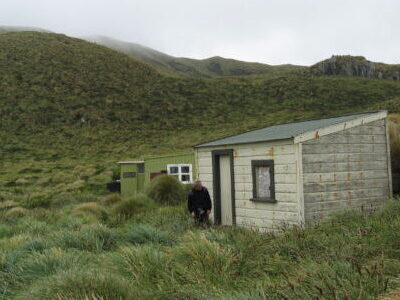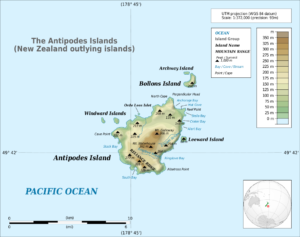For thousands of New Zealand’s sub-Antarctic mice, the next few weeks are the final countdown. With just a few weeks to go until mouse eradication begins on the sub-Antarctic Antipodes, this week’s Friday read looks at some of the key Antipodes-based research which has led us to this point – to the ‘Million Dollar Mouse’ operation. What impact have mice had on the main Antipodes Island?
John Marris Curator, Lincoln University Entomology Research Collection, visited the Antipodes in 1995 and, based on collections he made during that visit, along with museum collection records and literature reports, compiled a summary of the island group’s beetle fauna, their origins, distribution, ecology and biogeographical relationships. He also compared the terrestrial arthropod fauna of mouse-infested Antipodes Island with that of nearby mouse-free Bollons Island.

An unusual feature of the Antipodes Islands is that a large number of the invertebrate species are concentrated around the colonies of nesting birds – indeed, some species are not found anywhere else on the islands. The rich guano-fertilised soils provide good growing conditions for plants that invertebrates can feed on and feathers and other detritus also provide insect food and habitat.
Beetles are some of the world’s great decomposers and recyclers and, not surprisingly, play a key role in dealing with copious amounts of sea-bird guano on the Antipodes. So when large beetles become an easy and favourite food source of mice, this is not only bad for the beetles. The loss of beetles and other invertebrate recyclers can also potentially interrupt key nutrient recycling processes. By eating beetles and other insects, mice are also competing for food with native land birds such as Antipodes snipe and pipit.
The expedition was led by the Department of Conservation and visited the Antipodes Islands from
30 October to 29 November 1995. An initial visit of about seven hours was made to Bollons Island, with the remaining time solely on Antipodes Island. Marris later commented, “In most cases significantly more specimens were collected from Bollons Island in seven hours than from the main Antipodes Island in 26 days.”
The research team, while focused on beetles, also collected other invertebrate species. With respect to the impact of mice, Marris says the survey… “clearly illustrates the impacts mice are having on the main Antipodes Island invertebrates particularly the larger beetles. Differences in Coleoptera abundance between Bollons Island and the main Antipodes Island are dramatic.”
Twenty years have now passed since that expedition.
So what did Marris’s survey reveal about Antipodes invertebrates? “A total of 25 species is recorded from the islands, including seven new species and nine new distribution records from the islands. Nine species (36%) are endemic to the Antipodes Islands, 14 (56%) species are indigenous, one species is introduced and one is of unknown origin… Comparison between the invertebrate faunas of Antipodes Island and mouse-free Bollons Island indicate that mice have had a major impact on both the abundance and faunal composition of the Antipodes Island invertebrates.”
The full report of this survey is published in the Journal of the Royal Society of New Zealand and is freely available online.
The beetle (Coleoptera) fauna of the Antipodes Islands, with comments on the impact of mice; and an annotated checklist of the insect and arachnid fauna (2000, online 2010)

Five years prior to John Marris’s expedition, New Zealand’s Lepidopteran expert Brian Patrick travelled to Antipodes Island to check out the moth fauna, finding four species endemic to the island. In total he recorded 22 species, of which 20 were believed to be breeding there.
As well as a relatively high degree of endemicity, Patrick found that the Island’s Lepidoptera included a number of species that are morphologically distinct from main New Zealand populations in having shorter wing shape, colour and size. There were also a large number of moth species that were active during the day, including some species that could be active during the day or night. Many species were dependent on the open areas used by nesting birds.
Patrick also noted the mice – very many mice! “I noted diurnal activity of mice from the hut near Reef Point to the top of Mt Galloway. Their droppings were everywhere on the ground in herbfield and grasslands.”
Patrick goes on to surmise that, like the mice on Marion Island in the Indian Ocean, “the presence of these insectivores on Antipodes Island may therefore account for the lack of medium-sized flightless invertebrates, in contrast to Bounty Island where mice are absent.”
Brian Patrick concludes his research article with these words: “I recommend that if the technology to eradicate mice from larger islands becomes available in future, that Antipodes Island be given top priority for such an operation and that all due care is taken to avoid adverse effects on the resident bird species.”
That research report and recommendation was published in the Journal of the Royal Society of New Zealand 22 years ago. Now – in May/June 2016 – that time has come!
The full article is freely available: Antipodes Island Lepidoptera (1994)

